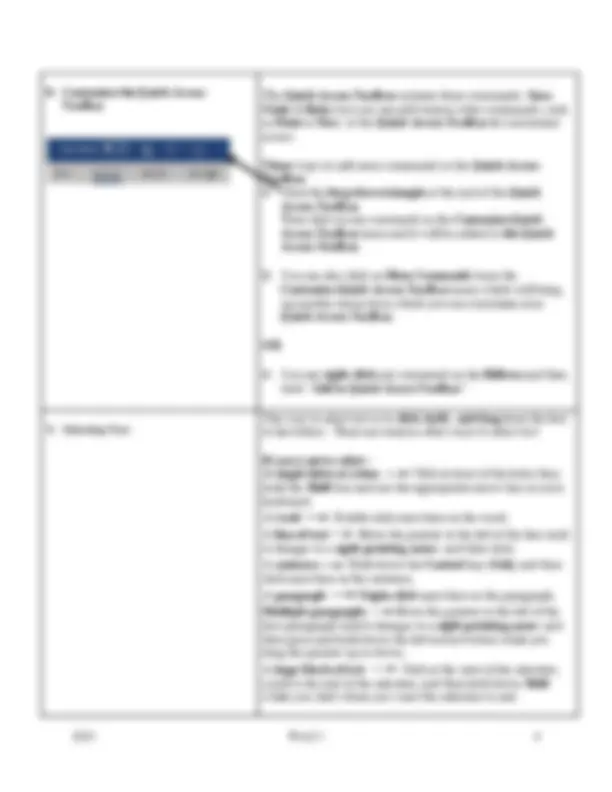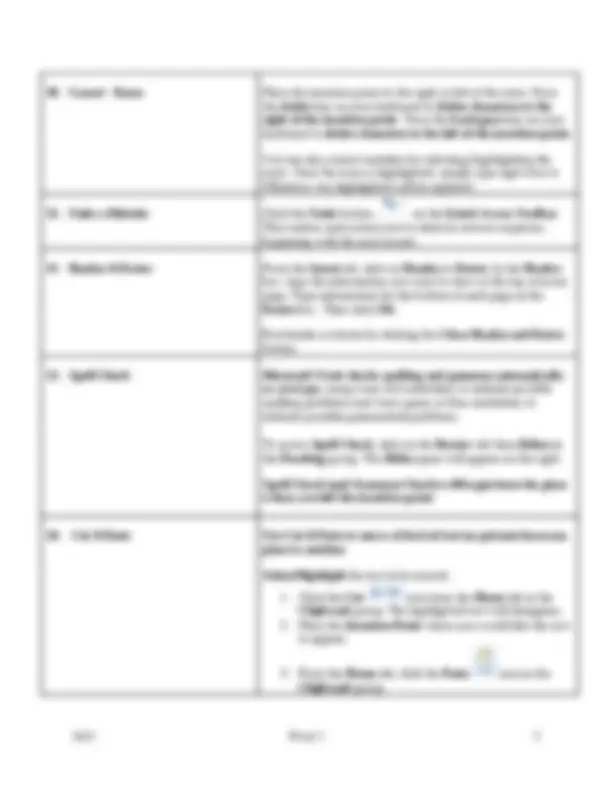





Study with the several resources on Docsity

Earn points by helping other students or get them with a premium plan


Prepare for your exams
Study with the several resources on Docsity

Earn points to download
Earn points by helping other students or get them with a premium plan
Community
Ask the community for help and clear up your study doubts
Discover the best universities in your country according to Docsity users
Free resources
Download our free guides on studying techniques, anxiety management strategies, and thesis advice from Docsity tutors
Open the Word program by clicking on the Microsoft Word icon in your taskbar. Then click on Blank Document. indicates where letters typed on the keyboard will ...
Typology: Schemes and Mind Maps
1 / 7

This page cannot be seen from the preview
Don't miss anything!




Quick Access Toolbar Located on the title bar, above the Ribbon, the Quick Access Toolbar provides access to AutoSave , Save , Undo and Redo. You can customize it by adding your favorite commands so that they are available no matter which tab you are using. Click on the drop-down triangle next to the Quick Access Toolbar and click on the action you want available on the toolbar. You will need to repeat for each addition. AutoSave defaults to “on.” Click to turn on or off. File Located on the top-left of the window, the File menu provides access to the functions common across all Office applications. Some of the functions found in the File menu for working with your file are Open, Save, Print, and Share. The Ribbon The Ribbon is a panel that houses the command buttons and icons needed for an application. Commands on the Ribbon are organized as a set of Tabs , each grouping relevant commands. Each application has a different set of Tabs, which expose the functions that that application offers. Within each Tab , various related options may be grouped together. Tabs & Contextual Tabs In Word 2019 , there are nine basic Tabs across the top of the Ribbon. Each represents an activity area. Each Tab has several Groups that show related items together. Some Tabs , called Contextual Tabs , appear only when certain objects are selected. Some commands are only available when the user is in a specific program or completing a specific task. For example, when you create a chart in Word, you see “Design” and “Layout” tabs , which contain commands that allow you to format your chart. If you select a picture, then the “ Picture Format” tab is exposed, presenting options which deal with the picture. Contextual tabs remain hidden unless their specific objects are selected. In previous versions of Word, names of the contextual tabs may have been different, but commands within were very similar. Mini Toolbar The Mini Toolbar is great for formatting options. Select or Highlight your text, and then point at the selection. The Mini Toolbar will appear in a faded fashion. If you point to the Mini Toolbar , it will become solid, and you can click a formatting option there. It also appears near the right-click menu when a user right-clicks on a selected word or words. Dialog Box Launcher (^) Some groups have a small diagonal arrow in the lower-right corner. The arrow is called a Dialog Box Launcher. If you click it, you'll see more options related to that group. Those options will appear in the form of a dialog box. Help Tab Click the Help Tab (formerly the? icon) to access the Help menu.
Mercer County Library System Brian M. Hughes, County Executive
Action Technique
1. Create a New Document Open the Word program by clicking on the Microsoft Word icon in your taskbar. Then click on Blank Document. 2. Insertion Point The Insertion Point is the thin flashing vertical bar ( ) that indicates where letters typed on the keyboard will appear. Move the insertion point to tell the program where you want to insert text, or pictures. To move the insertion point : - Hit the Enter key to move down to the next line. - Use the Backspace key to move to the left on a line containing text or up from an empty line. You can also move the insertion point by: - Using the four arrow keys on the keyboard; - Using the mouse; - Using the Tab key; - Tapping the Space Bar one character at a time. 3. Entering Text You can type continuously without pressing Enter to start a new line because the program "wraps" the text to the new line for you. When you reach the end of the line the text will automatically wrap to the next line. You only need to press Enter when you want to start a new **line or paragraph.
8. Customize the Quick Access Toolbar The Quick Access Toolbar contains three commands: Save , Undo & Redo , but you can add various other commands, such as Print or New , to the Quick Access Toolbar for convenient access. Three ways to add more commands to the Quick Access Toolbar:
Access Toolbar. Then click on any command on the Customize Quick Access Toolbar menu and it will be added to the Quick Access Toolbar.
Customize Quick Access Toolbar menu which will bring up another menu from which you can customize your Quick Access Toolbar. OR
click “ Add to Quick Access Toolbar !”
9. Selecting Text One way to select text is to click, hold, and drag from the first to last letters. There are various other ways to select text. If you want to select : A single letter at a time Click in front of the letter then hold the Shift key and use the appropriate arrow key on your keyboard; A word Double-click anywhere in the word; A line of text Move the pointer to the left of the line until it changes to a right-pointing arrow , and then click; A sentence Hold down the Control key ( Ctrl) , and then click anywhere in the sentence; A paragraph Triple-click anywhere in the paragraph; Multiple paragraphs Move the pointer to the left of the first paragraph until it changes to a right-pointing arrow and then press and hold down the left mouse button while you drag the pointer up or down; A large block of text Click at the start of the selection, scroll to the end of the selection, and then hold down Shift while you click where you want the selection to end.
10. Correct Errors Place the insertion point to the right or left of the error. Press the delete key on your keyboard to delete characters to the right of the insertion point. Press the backspace key on your keyboard to delete characters to the left of the insertion point. You can also correct mistakes by selecting/highlighting the error. Once the error is highlighted, simply type right over it. Whatever was highlighted will be replaced. 11. Undo a Mistake Click the Undo button on the Quick Access Toolbar. This undoes each action you’ve taken in reverse sequence, beginning with the most recent. 12. Header & Footer From the Insert tab, click on Header or Footer. In the Header box, type the information you want to show at the top of every page. Type information for the bottom of each page in the Footer box. Then click OK. Exit header or footer by clicking the Close Header and Footer button. 13. Spell Check Microsoft Word checks spelling and grammar automatically as you type , using wavy red underlines to indicate possible spelling problems and wavy green or blue underlines to indicate possible grammatical problems. To access Spell Check , click on the Review tab then Editor in the Proofing group. The Editor pane will appear on the right. Spell Check (and Grammar Check) will begin from the place where you left the insertion point. 14****. Cut & Paste Use Cut & Paste to move a block of text (or picture) from one place to another: Select/Highlight the text to be moved.
Clipboard group. The highlighted text will disappear.
to appear.
Clipboard group.
20. Change Case You can change the capitalization of words, sentences, or paragraphs by doing the following: Select/Highlight the text for which you want to change the case. On the Home tab, in the Font group, click Change Case , and then click the option that you want. 21. Bullets and Numbers Select/Highlight the text for which you wish to have bullets or numbers displayed. 1. Make sure you are on the Home tab 2. Click Bullets or Numbering in the Paragraph group. 3. Click the arrows next to the Bullets and Numbering icons to choose different bullets or numbering styles. 4. Click the style you desire. To add bullets or numbers as you type : 1. Click the mouse where you want the first number or bullet. 2. Type “1.” followed by a space (if you want a numbered list). 3. Type “ * ” followed by a space (if you want a bulleted list). When you press Enter for the next line a bullet or number will automatically appear. 22. Insert a Page Break (^) Click the mouse where you want to start a new page. Click the Insert tab, and then in the Pages group, click on Page Break. To insert a Section Break click the Layout tab, and in the Page Setup group, click the small black triangle next to Breaks , then click on the option you want. 23. Print the entire document or print only a selection To print your entire document, click File , then Print. Click Print again. To print fewer pages than the whole document, click File , then Print. Click the triangle next to Print All Pages. You can then choose to print a Selection , print Current Page , or print Custom pages (which gives you the option to print a range of pages). To print part of a document, select/highlight the desired information. Then click File , and click the triangle next to Print All Pages , then select Print Selection then Print. 24. Help Click the Help Tab to access a Help Menu. Click the Help icon
Microsoft Support, give them feedback, or watch video tutorial.